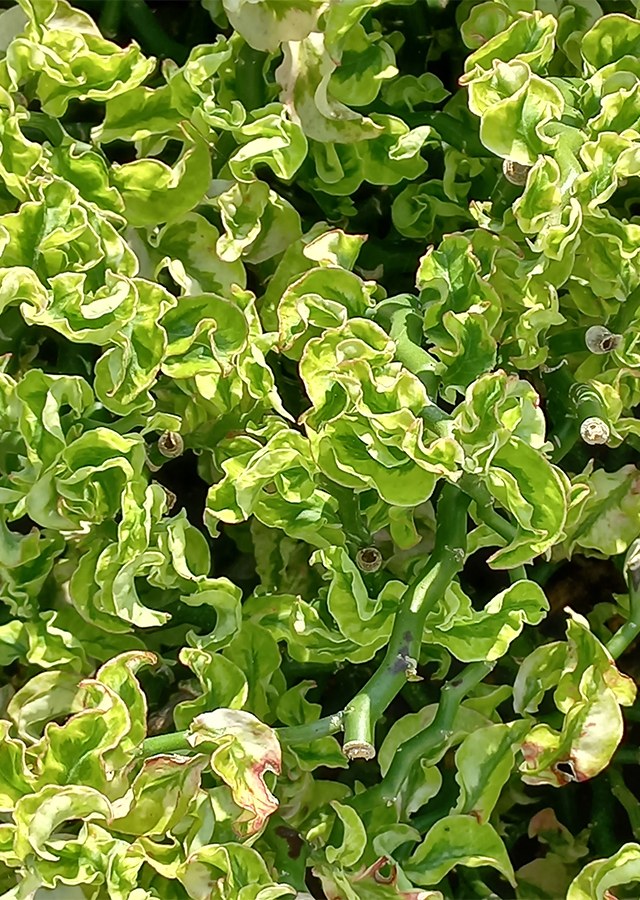Devil's Backbone
Euphorbia tithymaloides L.
Euphorbiaceae
Location in our garden
Principal



Synonym
Pedilanthus tithymaloides (L.) Poit.
Tithymalus tithymaloides (L.) Croizat
Habitus
Succulent. Succulent perennial with erect growth form, 40-70 cm in height.
Part Used
Leaves
Roots
Sap
Stem
Growing Requirements
Full Sunshine
Need Shade
Drought Resistant
Habitat
Coastal
Roadside
Shrublands
Terrestrial
Overview
Devil's backbone is a tropical and subtropical succulent plant. It is native to Florida (USA), Mexico, Central America, northern South America and most islands in the Caribbean. It has been introduced in Asia, Africa, Hawaii (USA) and a small number of islands in Oceania and the Caribbean. It has become naturalized in Bangladesh, Chad, Gambia, and Hawaii and is recorded as invasive in Cuba, the British Indian Ocean Territory, New Caledonia and Wake Island, one of the US Minor Outlying Islands. This species is a popular succulent that widely cultivated as an ornamental plant, often as a hedge or potted plant. In some areas, it is planted to remediate toxic soils. Plant parts are also used medicinally in China, it is used to treat traumatic injuries and fractures.
Vernacular Names
Hong que shan hu (Chinese), Herbe à cors, Lait à cors, Pantoufle (French), Gallito colorado, Itamo, Zapatilla de diablo, Zapatilla de duende (Spanish), Sapatinho do diabo (Brazil), Agia, Airi, Baire, Christmas candle (India), Gin-ryu (Japan).
Agroecology
Devil's backbone grows in a range of habitats including dry thickets, coastal savanna, wasteland, hillsides and along roadsides on rocky soils, at elevations from sea level to 1,200 m. It prefers dry and sunny conditions, but it can tolerate moderate shade. This species is adapted to grow on almost any soil type of pH 6.1-7.8. The soil must be sandy, well-drained, nutrient-rich, particularly in boron, copper, iron, manganese, molybdenum and zinc for its better growth, and it also has high drought tolerance. Annual rainfall is usually between 700 mm and 1,800 mm.
Morphology
- Roots - tap root, with few branches and numerous small lateral roots that show horizontal downward growth, light brown in color. Externally smooth with thin bark (easily gets peeled off exposing pale yellow inner part) which is featured with few cracks and fissures on its surface. It is slightly aromatic in odor but tasteless in taste.
- Stems - stout, slightly fleshy, strongly flexuous, glabrous or pubescent when young, round, zigzag stems produce, thick, dark-green in colour. The stem when broken exudes a caustic milky sap (latex) which gives mucilaginous taste. Its odor is slightly aromatic.
- Leaves - smooth, glossy, ovate or long ovate, fleshy, both surfaces pubescent, glabrescent, base rounded or obtuse, apex ± acuminate, with entire to slightly wavy leaf margins, the veins is pinnate, lateral veins 7-9 pairs. Alternately arranged with one leaf per point along the stem on alternating sides.
- Flowers - red, bird or beak shaped flowers, apex nearly labiate-shaped, 2-fid, lobes small, oblong, 3-serrulate at apex, glabrous. Cyathia in cymes clustered on leafless stems, terminal or axillary at upper part, each one with many male flowers and one female flower. Male flower has pedicels slender, glabrous, similar to filaments, anthers globose, slightly shorter than filaments. Female flower inserted at centre of involucres, glabrous, stigma three.
- Fruits - capsule, cuboid with truncated ends, deeply 3-lobed.
- Seeds - sub globose-ovoid, grey-brown.
Cultivation
Propagated by seed or cutting. Cuttings should be made above a joint, 13 to 15 cm long, and planted in sandy, nutrient-rich soil and allowed to root before planting.
Chemical Constituents
Euphorbol, beta-sitosterol, dammaronol A, dotriacontan-1-ol, friedelanol, hentriacontan-1-ol, cycloartenone, octacosanol, oxime, steroids, cardiac glycosides, kaempferol 3-O-b-D-glucopyranoside-6‟-(3-hydroxy-3-methylglutarate), quercitrin, isoquercitrin, scopoletin, tannins, triterpenes, coumarins, saponins, ursolic acid, luteolin, azafrin, and phenolic compounds.
Traditional Medicinal Uses
- This plant has powerful emetic, irritant and caustic properties. It is also known to possess anti protozoal, mitogenic, anti-inflammatory, antiplasmodial, antimycobacterial, anthelminthic, and antimicrobial activities.
- All parts of plant used medically to treat traumatic injuries and fractures.
- The leaves are brewed into tea to treat asthma, persistent coughing, laryngitis, mouth ulcers, and venereal disease.
- Tea brewed from the root has been used as an abortifacient.
- Its sap has been traditionally used to treat callouses, ear ache, insect stings, ringworm, skin cancer, toothache, umbilical hernias, and warts. In the West Indies, a few drops of the sap/latex is added to milk and used as an emetic.
- The root is known to be a powerful emetic.
Part Used
Reference Sources
- CAB International. 2021. Euphorbia tithymaloides (devil's backbone). https://www.cabi.org/isc/datasheet/121886#tohabitat. 08-11-2021.
- Flora Fauna Web. 2020. Euphorbia tithymaloides L. https://www.nparks.gov.sg/florafaunaweb/flora/2/3/2307. 08-11-2021.
- Poudel R., Srivastava R., Tripathi A., 2019. Pharmacognostical & Physicochemical Studies of Euphorbia tithymaloides (L.) Poit. IOSR Journal Of Pharmacy And Biological Sciences (IOSR-JPBS) 14(6): 17-24.
- EOL. Slipper Flower. https://eol.org/pages/1143754/articles. 08-11-2021.
- Srivastava R., Soni N. 2019. An updated review on phytopharmacological profile of Euphorbia tithymaloides (L.) Poit. The Pharma Innovation Journal, 8(5): 109-115.



